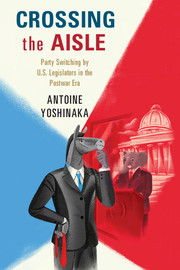Book contents
- Frontmatter
- Dedication
- Contents
- List of Tables
- List of Figures
- Acknowledgments
- PART I
- PART II
- 3 Why Do Members of Congress Switch Parties?
- 4 Progressive Ambition and Party Switching: Testing the Model on State Legislators
- PART III
- PART IV
- Appendix A Excluded “Pseudo-Switchers”
- Appendix B Details about Elite Interviews
- Appendix C Data Sources for Chapter 3
- Appendix D Data Sources for Chapter 4
- Appendix E Data Sources for Chapter 5
- Appendix F Data Sources for Chapter 6
- References
- Index
3 - Why Do Members of Congress Switch Parties?
from PART II
Published online by Cambridge University Press: 05 December 2015
- Frontmatter
- Dedication
- Contents
- List of Tables
- List of Figures
- Acknowledgments
- PART I
- PART II
- 3 Why Do Members of Congress Switch Parties?
- 4 Progressive Ambition and Party Switching: Testing the Model on State Legislators
- PART III
- PART IV
- Appendix A Excluded “Pseudo-Switchers”
- Appendix B Details about Elite Interviews
- Appendix C Data Sources for Chapter 3
- Appendix D Data Sources for Chapter 4
- Appendix E Data Sources for Chapter 5
- Appendix F Data Sources for Chapter 6
- References
- Index
Summary
The Arkansas Democrat is nothing like the national Democrat. [Arkansas Democrats are] hardworking people, they believe in God and motherhood and chivalry and apple pie, and the eastern liberals have pointy heads and they carry big briefcases around with nothing inside but ham sandwiches; that's my description of a national Democrat.
– U.S. Representative Tommy Robinson announcing his party switch in 1989In 1984, two-term Pulaski County sheriff Tommy Robinson was rumored to be interested in mounting a challenge to Bill Clinton for the governorship. Instead, Robinson ran for and was elected to the U.S. House of Representatives. As a conservative southern Democrat, Robinson's relationship with his party's congressional leadership was rocky. Not one to mince words, Robinson once told the Democratic chief deputy whip Bill Alexander to “take his warning and stick it…. [N]obody elected me to go and kiss [Democratic leaders’] rear ends” (Congressional Quarterly 1989, 77). Back home, Robinson's conservative views were in tune with those of his constituents; he easily won reelection in 1986 and 1988. After years of frustration in a party he once described as “a party of homosexuals and weirdoes” (Congressional Quarterly 1989, 77), Robinson switched parties and joined the Republican Conference in July 1989. The switch also appeared motivated by his intention to challenge Governor Bill Clinton, which he did unsuccessfully a year later. In a state that George H. W. Bush carried with 57 percent of the vote in the 1988 presidential election, it seemed reasonable for Robinson to think that switching to the GOP put him in a favorable position to win statewide office.
A few years later, several southern Democrats followed in Robinson's footsteps by defecting to the Republican Party in the aftermath of the watershed 1994 midterm elections. Two of these Democrats were Louisiana Representative Jimmy Hayes and Texas Representative Greg Laughlin. Among their many grievances with the party leadership, the two were displeased with their committee assignments: in the 104th Congress, Hayes had been assigned to the Committee on Transportation and Infrastructure and the Committee on Science, while Laughlin had only been assigned to Transportation. They became increasingly convinced that their voting record hurt their chances to receive good committees from the Democratic Steering and Policy Committee (Choate 2003).
- Type
- Chapter
- Information
- Crossing the AisleParty Switching by US Legislators in the Postwar Era, pp. 53 - 83Publisher: Cambridge University PressPrint publication year: 2015

